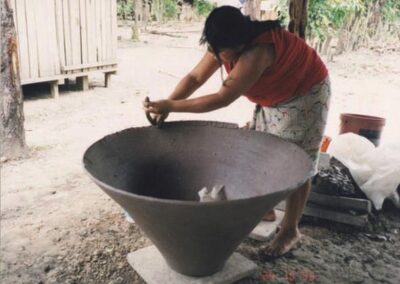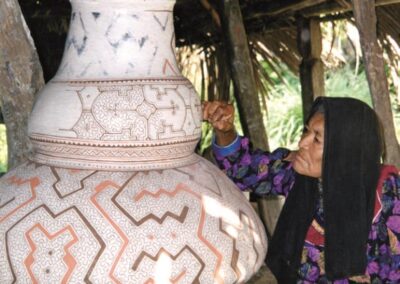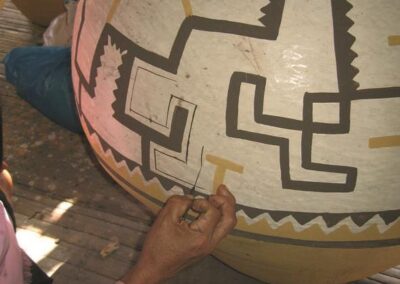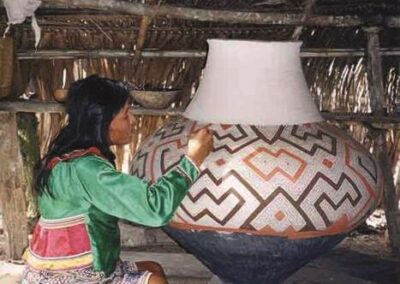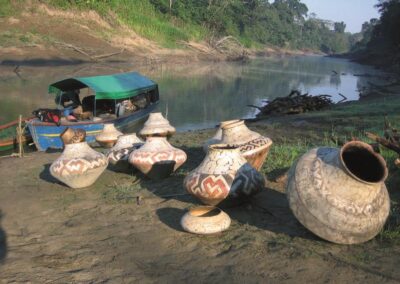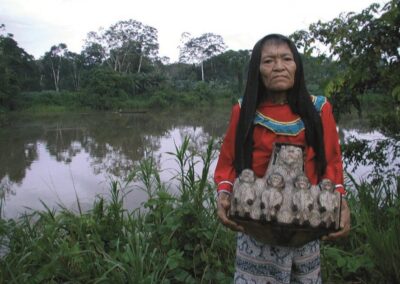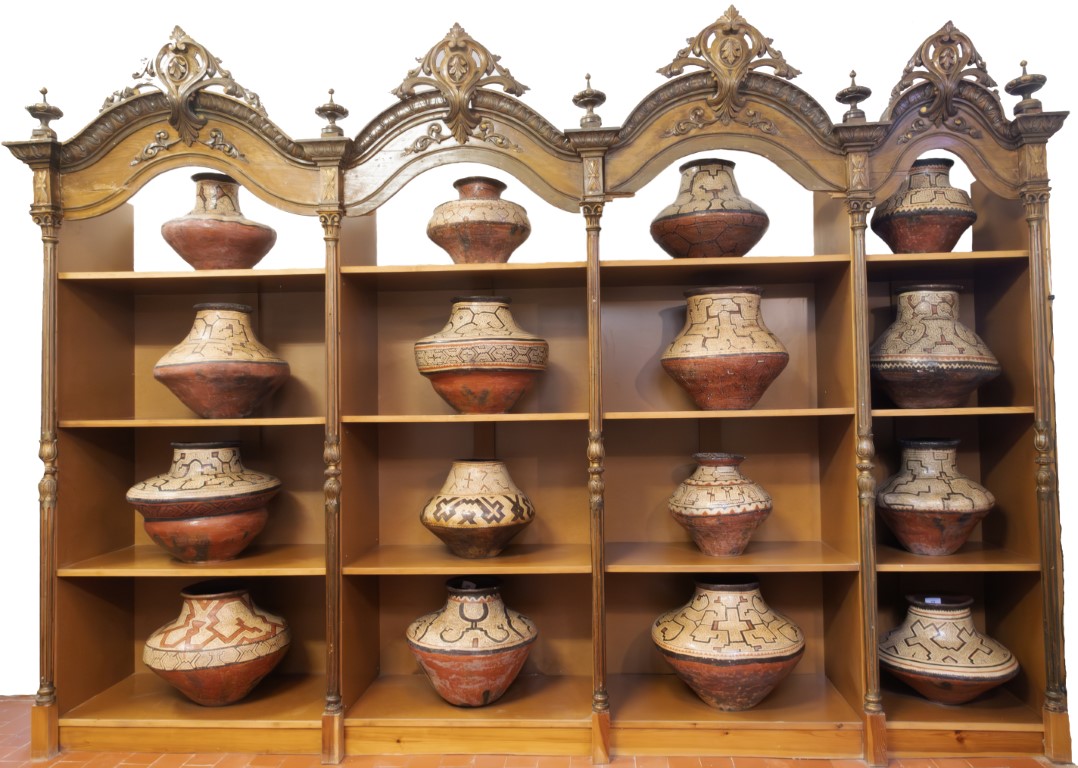“Ceramics hold the secret of the jungle… The Secret of the Ages”

The art of Shipibo
Clay is one of the materials that has first been transmitted to us by historical memory; Its malleability has left a record of cultures prior to us, of their knowledge and beliefs, their ways of feeling and expressing themselves. The association of clay and fire, through the firing of the earth, was a discovery that must have transformed primitive societies.
The ease of clay to represent ritual scenes or signs is a constant in most cultures on the planet, but it is perhaps in South America where the use of ceramics experienced an unparalleled development, serving us as an essential document since it not only allows us to date the sites but also provides us with conceptual and everyday information about the cultures that have made it.
Its versatility extends and transforms, to create shapes and volumes, transcending the plane beyond texts, engravings, drawings, colors or textures. It absorbs the void by generating a three-dimensional universe, where it can position itself or reflect itself, generating a subtle dynamic duality with no beginning or end.
In the Amazon basin, one of the first uses of pottery has been found: as a way of neutralizing the acidity of the soil, clay was roughly fired and buried as a way of retaining nutrients and being able to cultivate the land; These expanses of land are known as “terra preta” and are carbon-dated more than 3,000 years ago.
The designs of the ceramics of the Shipibo-Conibo ethnic group of the Peruvian Amazon, in the Ucayali River basin, in addition to their spectacular aesthetic value, are characterized by presenting several planes of symmetry, which gives them a very particular creative freedom, providing them with a similar harmony in the three spatial coordinates.
The designs tell us about the interrelationship of everything that exists, as well as the different paths that each one travels. Between the collective and the individual, a dynamic rich in nuances and suggestions is established, with the Constellation of the Southern Cross as a reference.
Its three worlds, represented by the parts into which the vessels are divided: Spirits, the Living and the Dead, cohabit in a continuous virtual plane, subject to the variations imposed by the different movements of the Earth in the universe.
In their Worldview they establish a calendar of alternating periods of light/dark, cold/heat, water/drought, associated with the different Earth orbits in interrelated cycles, which are resolved and completed in the changes of the magnetic polarity of the Planet.
This duality is also found in the overall structure of the various designs, which can be summarized in a fractal duality of shapes, which are developed and complemented, always being able to summarize them in a minimum number of steps in the different directions.
All the materials used in its creation are natural, following centuries-old techniques and knowledge. Mother Ayahuasca continues to suggest paths, in her turns, for those who want to go beyond matter. Water, represented by the cosmic serpent, relates everything, in its slow or tumultuous course. As a source of transformation, it impregnates the essences of visions and experiences of other places, of other materials.
The dichotomy between “scientific” and “local” knowledge, as well as “idealization” as a form of exclusion of the world’s indigenous peoples in the West, has undermined their knowledge. In the case of the Shipibo-Conibo, the meaning of their designs raises a cosmological knowledge, suggesting multiple possibilities of relationship.
Beyond the clay and its material manipulation, the designs take over the space creating a harmonious unity, which speaks to us of the stars and water, of fire and earth. In his discourse he incorporates animal and plant elements, with the same naturalness as conceptual or figurative elements.
The Shipibo and Ceramics
Among the Shipibo, ceramic work is distinctly feminine; They work with clay, called neapo, which is very plastic, which must be mixed with the ash of the bark of the Apacharama tree and ceramic fragments reduced to powder that act as an antiplastic or degreasing element that the ceramist patiently kneads to achieve a uniform mass, which she then converts into cylindrical strips.
With the so-called “Columbian” technique, they prepare a circular base with clay where this material is placed in strips and spirals, and then the object is modeled, the external and internal part is smoothed with a fragment of tutumo (fruit of the jungle with a very hard shell).
These objects are decorated with incisions made around them with the nails. The most common decorative motifs include the well-known geometric lines or kené (designs). Among the most elaborate are series of anthropomorphic vessels, in which men and women acquire different positions showing the sexes clearly defined; They also produce large jars in the shape of animals, such as the turtle and some birds of the region, just as often. The beautifully decorated pots are used to prepare food, cook ají (yellow hot cream chicken) and the larger one to prepare masato (fermented cassava liquor).
The pottery represents the Shipiba worldview: everything that is above in the sky is below on earth and both reflect each other; Hence, the constellations are the rivers, and the thick lines in the middle of them are the path of the sun-driven canoe.

The need to make the things necessary for everyday life has developed his creativity. The artist is a mediator between the material world and the world of spirits. The creation of an object is seen as an opportunity to express their cosmic beliefs, through the strong symbolic and spiritual content of their kené.
Three colors, red (ochre), black and cream appear in the Shipibo-Conibo polychrome pottery, as there are three variants of clay used, red, white and black.
They are collected during the dry season, in tanks known to each craftsman. Balls the size of the head (mapu) are prepared, removing all impurities from the dough, the very fine-textured clay can be stored for a year in the workshop.
The clay mixture is strengthened with temperant to prevent it from cracking during burning. It can be of two types: Apacherama, the bark of the caraipe tree containing silica that is charred and ground to a fine powder, and quenquésh, which comes from the recycling of broken fragments that are ground and sifted.
The potter grinds the clay balls with a crescent-shaped stone fulling mill. Mix the powdered clay with temperant and water to make a viscous paste. They build the pots by hand, twisting the previously prepared clay rolls in a spiral until the desired vessel size is achieved. They take advantage of the natural curves of the gourd to smooth the inner and outer walls of the pot with it. They usually use the rough tongue of the paiche fish as a scraper.
It symbolizes the human spirit within the earth womb awaiting birth.It symbolizes the human spirit within the earth womb awaiting birth.When the piece dries, they polish the outside with a black stone. Once dry, they gobble the piece with white clay (maush); the one from Canchahuaya in the lower Ucayali contains kaolin that dissolves in water until a creamy liquid is obtained. On the outer wall of the piece, a layer of white maush is spread. It is then polished again with the black stone.
Thus prepared, they begin to draw their designs with a sliver of cane or with a fine lock of their own hair. Three colors of mineral pigments are suitable for painting: red (manshinti), white (maush) and black (huiso). They usually travel once a year in search of these minerals.
It is not possible to burn pottery in the rainy months. Before burning, they are left to air for days. Large ceramics are burned outdoors using special firewood that can reach a high temperature, never reaching 700 C. The final burn lasts about 45 minutes, although it takes a lot of preparation beforehand.
A sunny day, without wind, is chosen to carry out the burning. After tempering the pot in the shade until noon, they roast it for half an hour over a fire that burns slowly, until it evaporates from the water retained by the clay. The piece looks totally black, charred.
Finally, they turn them upside down on three supports and pile up very dry pieces of wood from the cetic tree around them. They set fire to the pyramid of wood that is consumed with a spectacular blaze. The black layer has disappeared, giving way to an impeccable cream background paint.
The pottery is varnished with a natural, transparent resin (yómuesho) found under the muei tree. When the vessel is lifted from the fire, the outer wall is rubbed with the resin that melts to achieve the final shine. Inside, it is waterproofed using black pitch (sénpe) from the carob tree, applying it with the bent rib of the manatee.
The Shipibos use two types of dishes, the quempo, known throughout the jungle as mocahua, which is used to drink liquids and therefore has decorations related to water on the inside and outside; and the quencha, used for eating and which is only decorated on the outside. Inside, it has the colour of clay or in some cases black colour from the smoke produced during firing.
The large pitcher, mahuetá, which can measure up to 120 centimeters, is used to ferment large quantities of the masato consumed at festivals and communal gatherings.
Archaeologists have discovered in Caique that the Conibo of Alto Ucayali had the habit of burying their dead inside large containers. Until now, the word mahuetá in their language, the pano, means ‘dead’. Funeral urns have female faces and sexes. They depict a kneeling Shipibo woman with legs spread, about to give birth. The dead person was placed in the vessel in the fetal position. It symbolizes the human spirit within the earth womb awaiting birth.
Some pieces have ceased to be manufactured, such as vessels with tripod legs in the shape of a cross, in the shape of a manatee, pitchers with very well modeled anthropomorphic decorations and with human features. It is quite possible that these works had a purely ceremonial function and were used in rites that have probably been lost.
The important thing about the Shipibo tradition has nothing to do with the support or the production technique that has been adapting to thousands of changes that modern society imposes and that the economy of these groups does not allow to maintain, but the designs that still remain in force despite the time that has elapsed.
Kené and writing
Kené, in the Pano language, means “design”. It is used to designate geometric patterns made by hand on a wide variety of surfaces (ceramics, fabrics, body, oars…). Graphics occupy a key position both in art and in the ritual practices of all groups, although they acquire their own modalities in each ethnic group.
It is not a figurative art or mere plastic expressions; According to his thoughts, they are a materialization of the energy or positive force of the plants called “rao” or power plants, and there is a great variety of them.
We could say that the “kené” are a form of writing that is lost in the mists of time, transcending matter and bringing us closer to its spiritual world.
In agraphic cultures, the role played by symbols made of clay or carved in stone as a means of expressing and transmitting the worldview is a worldwide constant. We could compare them, in terms of their meaning and social function, to Egyptian hieroglyphs if we take into account the different development and worldview.
The jungle has served as a territorial boundary and protector just like the desert in Egypt; While in one case there was an adaptation to the environment by developing a vertical social structure, with the Pharaoh and his god Ra at the apex of the pyramid, to facilitate the harvesting and distribution of food according to the rhythm imposed by the floods of the Nile, In the Amazon basin, a social system based on small communities was developed due to the acidity of the land and its production capacity, among other reasons. The inhabitants of the Amazon adapted to the periodic transformations of the river, while in the Nile they managed to tame it to some extent.
Comparing the two types of social development, one based on scarcity and the need for storage, and the other based on the abundance and impossibility of storing and domesticating the course of the Amazon can give new insights into the evolution of humanity.
Shipibo women use natural materials and highly complex design techniques. The designs have a fusion of form, light and sound. When women look at their designs, what they are perceiving seems to be a tune. The designs extend beyond the supports themselves, populating and protecting all spaces.
What we perceive as a graphic demonstration, they perceive as a melody. Each design has its own melody. Two or more women, who paint a large vase or mahuetá simultaneously, can be aware of what their partner is painting just by listening to the melody she sings. The melody corresponding to the design in which they are occupied. Once they come together, on the other side of the piece, the designs will start and end in the same place, without the artists having agreed or seen what the others were doing.
The paths and landscapes to travel, the coexistence in community represented by a central circle, the plants, the animals, the large and small rivers, all are represented in her work on the loom or in her embroidery, creating a speaking surface of her own life.
Today, women have developed their own technical and descriptive language, which they apply to their work. They never repeat the same design because they consider that everything that exists on earth or in the universe is populated by them, and there are so many, why repeat them?
The main line of each design usually represents Ronin, the cosmic serpent, who has created the universe and symbolizes the creator. This gives the basic rhythm of the design; The longer it is, the more admiration it will cause, presenting multiple variations on the same theme, with an infinite number of twists and turns coiled like an endless serpent.
The secondary lines run parallel to the main ones, as an echo of the dominant theme, in a minor key. Fine fill lines, traditionally octagonal in shape, should fill the remaining void.
Even if they look alike, you never see two pieces with the same design. The motif, which is initially perceived as a positive design on a negative background, can also be seen the other way around. A great artist must maintain a perfect balance between positive and negative elements.
The designs give the impression that they can be compressed into a much more limited space, or that when extended they would cover the entire world if they were not limited by the edge of the cloth or the rim of the vessel. The designs follow an endless trajectory in the imagination.
Each large pitcher of the Shipibo-Conibo group represents the three worlds of their cosmology. The lower part, where no design appears, represents the lower, subterranean world. By filling the jar with masato for the Ani Sheati feast, this part is buried. The area between the waist and neck of the vessel represents the earth world and daily life with its unexpected events. The upper part, from the neck to the mouth, represents the heavenly world.
For the Shipibo-Conibo, medicine is closely related to their cosmic vision. They believe in the existence of other worlds beyond the world we live in. They live our world of appearances as a mirror of the supernatural or celestial world. Balance, or dynamic tension between positive and negative aspects, is necessary to maintain harmony.
The anaconda, in its positive and beneficial aspect, is considered the manifestation of the divine spirit and brings rain and fertility indispensable for life. In its negative aspect, the anaconda is symbolized by the rainbow which, according to them, brings diseases and misfortunes.
The world of the Shipibo-Conibo, who believe that everything that exists is composed of designs, is really an opening to the infinite, to the non-immaterial. It is a source of wise knowledge and a harmonious way of life, of respect for the environment, the human, the divine and creation.
The principle/law of reciprocity between man and the forces of nature, between the living and the dead, and between peoples, lessons learned from their god Viracocha, created the essential cultural tool for shaping such a complex physical environment. The Quechua word “Pacha” simultaneously means place and time; Understanding the relationship between the two concepts is essential to understanding the dynamic conception of the Andean and Amazonian world.
The Milky Way, a vast celestial river in Andean cosmology, crosses the Peruvian sky at an angle of about 28 degrees to Earth’s orbit. Over the course of six months the flow of stars passes from northeast to southwest, tilting from southeast to northwest for the other six months. The transition coincides with the transition from the dry season to the rainy season, and divides the sky into four sectors.
The control of the stations was a priority for the development of Amazonian cultures; For this reason, the knowledge of the movements of the constellations was fundamental, with the Southern Cross being a basic reference in their calendars. Andean myths and their architectural expressions are elaborated along the lines of a hologram; Its parts cannot be analysed in isolation from the whole. The Milky Way was considered, more than a celestial object, a tool for the organization of calendars or socially useful rituals.
A peculiarity of the Southern Cross is the fact that it contains the Golden Ratio. If we take the distance between the two horizontal stars as a unit and draw a square, the diagonal of that square has the distance between the two vertical stars of the four stars that make up the constellation of the Southern Cross.
An increasing number of researchers have come to the conclusion that the Amazon basin, far from being the timeless virgin land, is considered the current jungle to be the result of a historical interaction between the environment and humans.
The life of the Indians of the Amazon, after reaching a cultural level adapted to their ecosystem, changed little. The island of Marajó located at the mouth of the Amazon, larger than the size of Holland, can be considered a good proof. The mastery and quantity of pottery found shows that a developed society lived around 1,400 BC. C.; It possibly had more than 100,000 inhabitants and covered thousands of square kilometers. In the area of Santarém there is a cave called “Caverna da Pedra Pintada” with cave paintings made around 6,000 BC. C.; the pottery found there and elsewhere in the region is among the oldest in the Americas.
Its history is part of the richness of the Peruvian Amazon, of that land that for centuries was the great challenge of the conquerors and evangelizers. The Shipibo and Conibo, the two ethnic groups that once fought each other, have given rise to this new race of natives who live near the lagoons and rivers and most of them are settled in the district of Yarinacocha, which is home to several communities.
The true origin of the Shipibos is still a mystery, but according to their racial characteristics, some anthropologists suppose that like any other native immigrant group, they came down from the Andes centuries ago and adapted to the geographical conditions of the region. Others believe they came from Central America along the coast or by entering through rivers, but others believe they came from Cahuapanas and the Marañón, in the Amazon area.
In their dresses you can notice the diversity of striking colors, and in their way of speaking they often use unusual expressions. Many of those who do not belong to the Amazon area might think that the myths and legends of the Shipibo, which speak of goblins and devils, are nothing more than a superstitious explanation of the mystery of the jungle, but they say that things do exist, that only nature knows.
Calendars & Measurements
The Earth wanders in the historical universe following, simultaneously, several directions; Just as the Rotation is associated with day and night, and the Translation with winter and summer, the movement of Precession, subdivided into 1,200 Nutations of 18 years and 6 months duration, seems to be associated with periods of time with a greater or lesser rise of the waters.
In the tropics, the first two movements do not involve major alterations, while the precession movement, associated with the flooding of the river, means that the channel rises 9 or 10 meters in height, with a width of up to 200 kilometers, periodically flooding villages and crops.
The behavior of the Earth, seen as a particle in a magnetic field, changes polarity in the course of successive movements, establishing, in addition, a dynamic behavior between the various movements.
The relationships between the movements of the Earth can be established taking into account the existing symmetries, not only between the orbits of the motions but also with the symmetries existing between the spaces included in the Earth itself considered as a Three-Dimensional Object.
The relationship between the orbits of the movements of the Earth, as a Physical Unit, and the component particles of that Physical Unit, maintain a constant and dynamic fractal structure.
As a constant structure, it maintains proportions and symmetries; As a dynamic structure, it changes the magnetic polarity to maintain the orbits, describing a continuous and cyclical space/time plane, like a Möbius loop in which the symmetry relations are extended in geometric proportion.
We can visualize it as particles rotating in several directions at the same time, and simultaneously static at each of the positions of the orbits described. That space occupied by the particles and their orbits, on another scale, would become a new Physical Unit with another dimension.
The materials used in the elaboration of clay is a whole universe of discoveries and surprises; The subtlety of mineral and plant combinations offers a delicate play of consistencies and densities with a clear boundary between being and nothingness.
The various elements are combined again with water and fire to become an object, and at the same time a subject, acquiring in the process of transformation other densities and consistencies, apt to be a support for new games of balances and meanings, enduring in a temporal coordinate.
A formless, plastic and malleable material, rich in initially unstable forms, has in this process become a material stable in form and meaning.
Shipibo designs are traces of knowledge that brings us closer to the history of the Earth and its inhabitants. Considering the vessels under the cubic holohedrage, we find a series of symmetries and equivalences that respond to a concept of expressive freedom that is difficult to overcome.
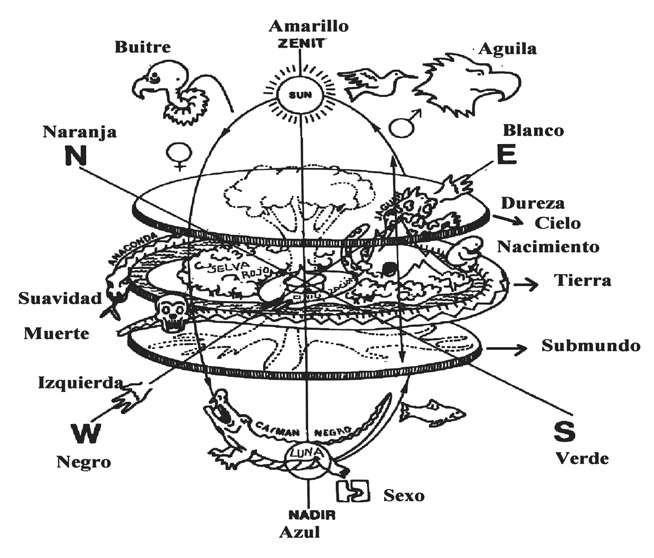
Each design is the result of a spatial conception in which it is possible to establish equivalent symmetrical relationships between the different parts of the designs, as well as to express a universe, the vessel itself, with a simultaneous harmony in the three degrees of freedom of three-dimensional space.
The motifs that are reiterated in the designs cover the surface of the vessel until it is completed circularly, presenting a duality so that each stroke has another corresponding associated one, just as half of the design is associated with the other half, in the axes, planes and center of symmetry of the cubic holohedrage, recalling a fractal behavior at different scales.


